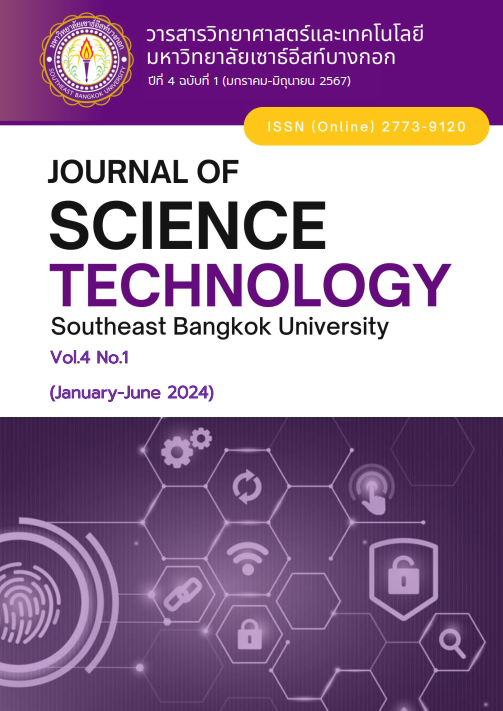การประยุกต์ใช้หลักการ DMAIC ตามแนวคิดของซิกซ์ ซิกม่า เพื่อลดของเสียในกระบวนการเชื่อมประกอบรถยนต์ บทความวิจัย
Main Article Content
บทคัดย่อ
งานวิจัยในครั้งนี้มีวัตถุประสงค์เพื่อลดของเสียลักษณะสะเก็ดไฟในกระบวนการเชื่อมประกอบรถยนต์ ให้ไม่เกินร้อยละ 0.2 ของยอดการผลิตต่อเดือน จากปัญหาของเสียลักษณะสะเก็ดไฟ ที่เกิดขึ้นในกระบวนการเชื่อมประกอบฯ จึงได้ทำการเก็บรวบรวมข้อมูลของเสียย้อนหลังจำนวน 7 เดือน จากยอดการผลิตรถยนต์ 48,260 คัน พบว่าของเสียลักษณะสะเก็ดไฟจำนวน 490 ชิ้น หรือมากกว่าร้อยละ 0.2 ของยอดการผลิตต่อดือน จึงประยุกต์ใช้หลักการ DMAIC เป็นขั้นตอนการแก้ไขปัญหา ทำการวิเคราะห์สาเหตุด้วยแผนผังเหตุและผล นำสาเหตุที่ได้จากการวิเคราะห์ไปหาระดับคะแนนเพื่อลำดับความสำคัญ พบว่าสาเหตุย่อยของคะแนนที่มากกว่าร้อยละ 80 คือเกิดจากสาเหตุการปรับตั้งกระแสไฟไม่เหมาะสม จึงได้เลือกนำไปแก้ไข โดยออกแบบการทดลองเพื่อหาค่ากระแสไฟที่เหมาะสมในการเชื่อมประกอบฯ โดยการทดลองนั้นประกอบด้วยตัวแปร
ที่เกี่ยวข้อง คือ 1) แรงกด 2) เวลาที่ใช้ในการเชื่อม และ 3) กระแสไฟเชื่อม มาทำการทดลองเชิงแฟกทอเรียล 3k และวิเคราะห์ผลการทดลองด้วยโปรแกรมสำเร็จรูป Minitab ผลการทดลองพบว่าค่ากระแสไฟที่เหมาะสมในการเชื่อม คือ
ค่าแรงกดเท่ากับ 3.6 กิโลนิวตัน/เมตร เวลาที่ใช้ในการเชื่อมเท่ากับ 250 มิลลิวินาที และกระแสไฟเชื่อมเท่ากับ 7.8
กิโลแอมแปร์ซึ่งได้ปริมาณของการเกิดสะเก็ดไฟเท่ากับ -0.197 ซึ่งเป็นการเกิดสะเก็ดไฟที่น้อยและเหมาะสม ส่งผลให้จำนวนของเสียก่อนปรับปรุงเฉลี่ยเท่ากับร้อยละ 0.998 ต่อเดือน หลังปรับปรุงลดเหลือเฉลี่ยเท่ากับร้อยละ 0.023 ต่อเดือน และระดับซิกซ์ ซิกม่า ก่อนปรับปรับเท่ากับ 4.25 หลังปรับปรุงเพิ่มขึ้นเท่ากับ 5.33 บ่งชี้ถึงระดับคุณภาพของการกระบวนการที่ดีขึ้น
Article Details

อนุญาตภายใต้เงื่อนไข Creative Commons Attribution-NonCommercial-NoDerivatives 4.0 International License.
บทความที่ได้รับการตีพิมพ์และเป็นลิขสิทธิ์ของวารสารวิทยาศาสตร์และเทคโนโลยี มหาวิทยาลัยเซาธ์อีสท์บางกอก
เอกสารอ้างอิง
Industrial Intelligence Unit: IIU, Economic Office Industry (OIE), “Summary of the Situation of the Modern Automotive Industry Towards the Goal of a Sustainable Economy,” [Online]. Available: https://iiu.oie.go.th/images/document/pdf/20230311135311.pdf. [Accessed: Jan. 08, 2024].
M. Poppendieck, “7 Wastes,” [Online]. Available: http://www.moro.co.th/the-7-wastes. [Accessed: Jan. 08, 2024].
K. Pari, “7 Wastes,” [Online]. Available: https://greedisgoods.com/7-waste. [Accessed: Dec. 18, 2023].
FDI, “7 Wastes,” [Online]. Available: https://fdirecruit.co.th/7-waste. [Accessed: Dec. 03, 2023].
F. W. Breyfogle, Implementing Six Sigma: Smarter Solutions Using Statistical Methods, USA: John Wiley & Sons, 1999.
THANAYUTSITE, “7 QC Tools,” [Online]. Available: https://thanayutsite.wordpress.com/. [Accessed: Oct. 09, 2023].
N. Mahanil et al., “Reducing Waste in the Liquid Detergent Packaging Process by Applying the Six Sigma Concept,” Journal of Science and Technology, Southeast Bangkok University, vol. 3, no. 1, pp. 1-12, 2023.
T. Sriram et al., “Application of the DMAIC Model to Reduce Waste in the Eye Drop Bottle Caps Manufacturing Process,” The 6th National Conference on Informatics, Agriculture, Management, Business Administration, Engineering, Sciences and Technology: IAMBEST 2021, King Mongkut's Institute of Technology Lat Krabang, Chumphon Khet Udomsak Campus, Thailand, pp. 52-60, 2021.
A. Nuprim, “Defect Reduction in a Manufacturing Process; A Case Study in Gloves Manufacturing,” M.Eng. thesis, Department of Industrial Management , Prince of Songkla University, Thailand, 2020.
K. Athikulrat and S. Yindeemorh, “Application of Six Sigma to Reduce Waste from Wire Spokes Production Process: A Case Study on Motorcycle Parts Factory,” KMUTT Research & Development Journal, vol. 43, no. 3, pp. 227-296, 2020.
W. Wannasathit, 7 Quality Control, Business Bulletin Service Co., Ltd., Bangkok, Thailand, 2016.
S. Saiklai, 4M1E Principle, Piyawatana Co., Ltd., Bangkok, Thailand, 2014.
S. Manochai and S. Jongprasithporn, “Productivity Improvement by Design and Analysis of Experiments Case Study: Base of Choke Up,” Graduate Research Conference, Khon Kaen University, pp. 194-202, 2012.
N. Saengsawang and J. Ounwong, “Quality of Resistance Spot Welding Joints of Galvanized Steel With Aluminum 5052 and Stainless Steel 304,” Industrial Engineering Network Academic Conference, Sripatum University, Phetchaburi, Bangkok, pp. 1319-1330, 2012.
M. Magumhin and W. Dokchan, “Reducing of Waste in Filling Processes: A Case Study of Medicinal Products for Human Factory,” Journal of Technical Education Development, vol. 35, no. 124, pp. 63-72, 2022.
W. Kaewyindee et al., “Waste Reduction of Dyeing and Finishing Process by Six Sigma,” Graduate Research Conference, Rangsit University, pp. 2529-2536, 2018.


